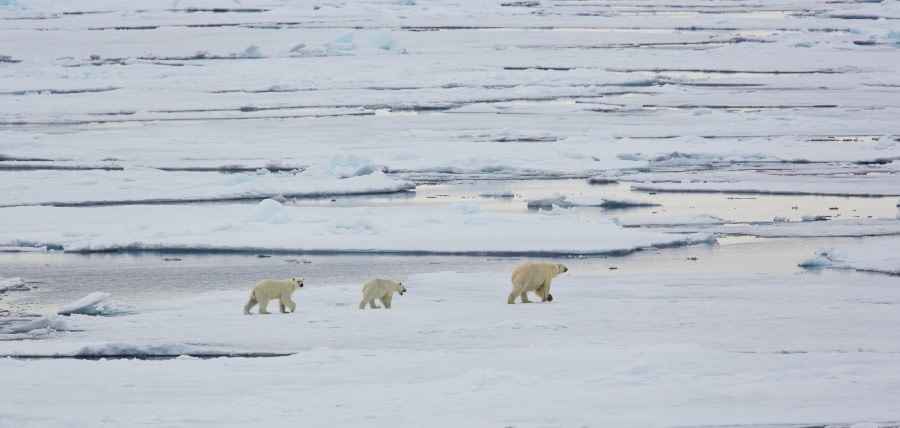Plancius is a 267-foot oceanographic research ship fully rebuilt and ice-strengthened in 2010 for use for polar expeditions. Originally built in 1976 for the Royal Dutch Navy, it has been converted to a spacious and comfortable vessel for exploring both the Arctic and Antarctic areas. Onboard the ship you will find a panoramic observation lounge with a bar and a library, an airy restaurant, and large open deck spaces with excellent opportunities to enjoy the scenery and spot wildlife. Both observation lounge and restaurant will host frequent lectures by naturalist guides. Tasty meals are prepared by international chefs and feature a variety of cuisines.
Plancius has 53 cabins for a maximum of 110 passengers. Ten superior cabins are the largest and offer one queen-size bed each. 39 twin cabins have either a queen-size bed or two lower single beds. Four triple cabins have a bunk bed and a lower single. All cabins have private bathrooms and plenty of storage space. Due to the remote expedition areas, there’s an infirmary and a doctor onboard. Ten zodiacs will whisk you to the many land excursions and wildlife sightings.
Start your North Spitsbergen cruise with a trek around historic Longyearbyen, then join our expedition to the north of the island to take in the fantastically beautiful landscapes, the thousands of seabirds, and of course the star of the show, the polar bear.
Day 1: Largest town, biggest island
You touch down in Longyearbyen, the administrative center of Spitsbergen, the largest island of the Svalbard archipelago. Enjoy strolling around this former mining town, whose parish church and Svalbard Museum make for fascinating attractions. Though the countryside appears stark, more than a hundred species of plant have been recorded in it. In the early evening the ship sails out of Isfjorden, where you might spot the first minke whale of your voyage.
Day 2: Route to Raudfjorden
Sailing to Raudfjorden, on the north coast of Spitsbergen, you take in an expansive fjord spilling with glaciers – and maybe even visited by ringed and bearded seals. The cliffs and shoreline of this fjord also support thriving seabird colonies, rich vegetation, and the possibility of polar bears.
Day 3: The massive Monaco Glacier
Depending on the weather, you could sail into Liefdefjorden and cruise within sight of the 5-kilometer-long (3.1 miles) face of the precipitous Monaco Glacier. The waters in front of this glacier are a favorite feeding spot for thousands of kittiwakes, and the base of the ice is a popular polar bear hunting ground. If ice conditions prevent sailing here early in the season, an alternate route along the west coast of Spitsbergen can be implemented.
Day 4: Highlights of Hinlopen
Today you sail into Hinlopen Strait, home to bearded seals, ringed seals, and polar bears. At the entrance there is even the possibility to spot blue whales. After cruising among the ice floes of Lomfjordshalvøya in the Zodiacs, you can view the bird cliffs of Alkefjellet with their thousands of Brünnich’s guillemots. On the east side of Hinlopen Strait, you may attempt a landing on Nordaustlandet. Here reindeer, pink-footed geese, and walruses are likely sights. You can take an alternate route if ice prevents entry into Hinlopen.
Day 5: Stop at the Seven Islands
The northernmost point of your voyage may be north of Nordaustlandet, in the Seven Islands. Here you reach 80° north, just 870 km (540 miles) from the geographic North Pole. Polar bears inhabit this region, so the ship may park for several hours among the pack ice before wheeling around west again.
Day 6: Sailing the continental shelf
While retracing your route west, keep watch for polar bears and elusive Greenland (bowhead) whales. About 40 nautical miles west of Spitsbergen, you sail the edge of the continental shelf. Here fin whales forage during the summer in the upwelling zones (where cold, nutrient-rich water wells up from below the sea’s surface) that run along the Spitsbergen banks. At the mouth of Kongsfjorden, you have a good chance of sighting minke whales.
Day 7: Reindeer, foxes, and so many seabirds
Walruses sometimes haul out in Forlandsundet, your next stop. Alternatively, you might sail into St. Johns Fjord or south to the mouth of Isfjorden, landing at Alkhornet. Seabirds nest on these cliffs, Arctic foxes search below for fallen eggs and chicks, and reindeer graze the sparse vegetation. You arrive in Longyearbyen later at night.
Day 8: There and back again
Every adventure, no matter how grand, must eventually come to an end. You disembark in Longyearbyen, taking home memories that will accompany you wherever your next adventure lies.

Polar Sales!
North Spits on Sale
Mar 23-May 4, 2025 - Atlantic Odyssey - from $16380
Jun 10-28, 2026 - North Spits - from $6240
* Plus free Zeiss binoculars - limited time offer